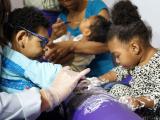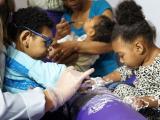The first follow-up of babies born with Zika-related microcephaly and related defects reveals that by age 2, they experience a range of serious disability and health problems, which can become more apparent as they get older.
Experts have predicted that the infants born with Zika and their families face a life of tough challenges, but they're just now starting to document how the problems unfold, or whether any new ones surface, as the children get older. The findings could help health providers in Brazil and other countries, including the United States, better plan care and resources for affected children.
The team from Brazil and the US Centers for Disease Control and Prevention (CDC) reported its findings today in the latest issue of Morbidity and Mortality Weekly Report (MMWR).
Many kids have multiple problems
The scientists examined 19 children from Brazil's Paraiba state who were born between Oct 1, 2015, and Jan 31, 2016, and diagnosed as having Zika-related defects when they were 1 to 7 months old. They were examined for the study at ages 19 to 24 months. All were part of an earlier case-control study that strengthened the link between Zika virus, microcephaly, and other congenital defects.
The researchers performed health and development assessments on the children, including seizure screening, interviews with caregivers, and examination of medical records. They found that 11 had evidence of possible seizure disorders, and 10 had sleep difficulties. Nine had problems with feeding, such as difficulty swallowing.
In earlier studies, clinicians had identified eye problems, and the follow-up study found that 11 had vision problems, such as inability to follow a moving object with their eyes. Of those, only 4 had retinal abnormalities on clinical exam. Thirteen had hearing problems, such as not responding to the sound of a rattle.
Fifteen kids had severe motor impairment, including the inability to sit on their own, and 14 had at least three such problems, which complicated their care.
Regarding other health problems, eight had been hospitalized, most commonly with pneumonia or bronchitis.
Head circumference measurements found that 15 of the 19 children were at least three standard deviations below the mean for their age or sex. Four had an increase in circumference since birth—three were within one standard deviation below their means and one had a circumference one standard deviation above the mean.
Some problems heighten with age
The team said the follow-up findings expand on observations seen in newborns, showing that the spectrum of problems as children grow older can include severe motor impairment and impaired response to visual and auditory stimuli—and the defects are seen in most affected youngsters, becoming more apparent as they age.
"Many of the initial findings identified at birth remain present at ages 19–24 months, and these children are falling far behind in achievement of age-appropriate developmental milestones, indicating the need for long-term follow-up and support," the authors wrote.
Brenda Fitzgerald, MD, CDC director, said in a CDC press release today, "Continued monitoring of all children with congenital Zika exposure is critical to understand the full impact of the infection during pregnancy and to support these families for the long-term."
See also:
Dec 14 MMWR report
Dec 14 CDC press release





















